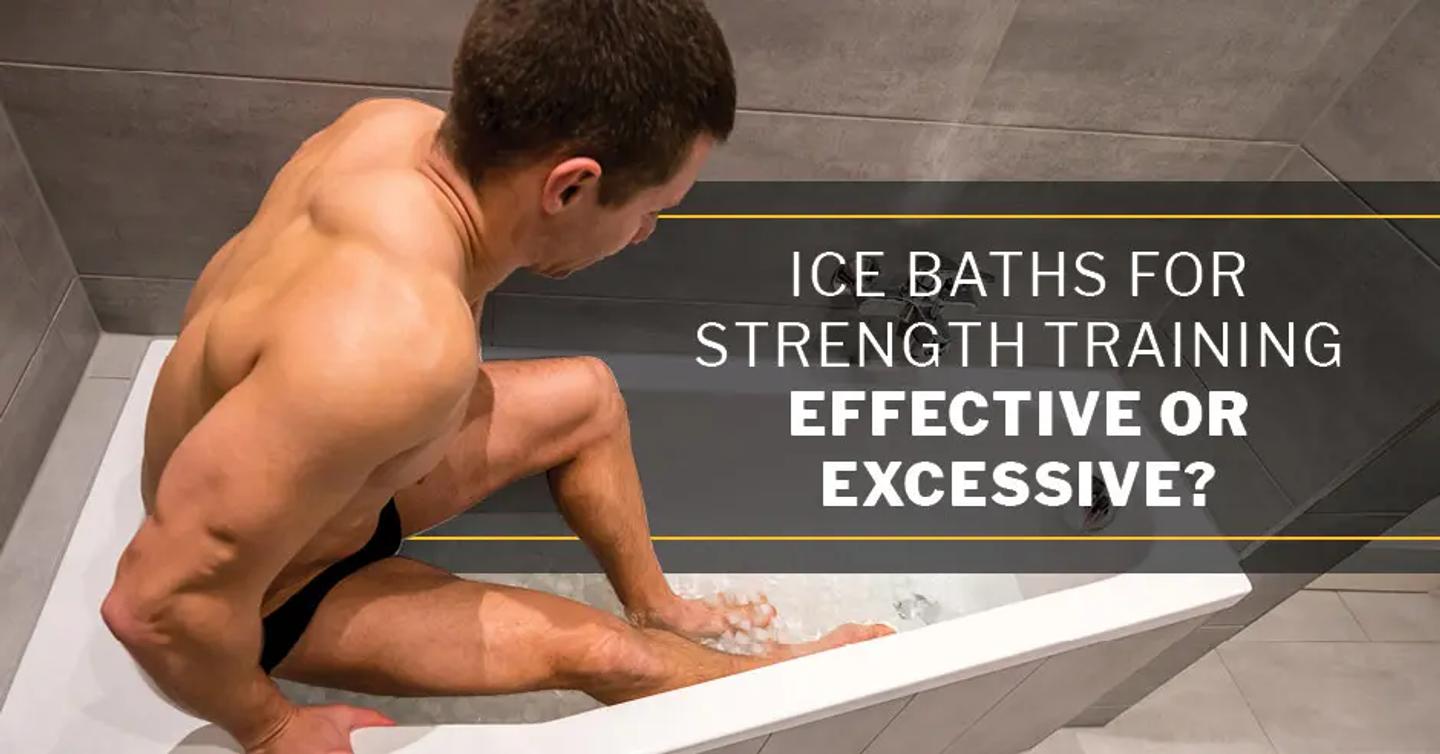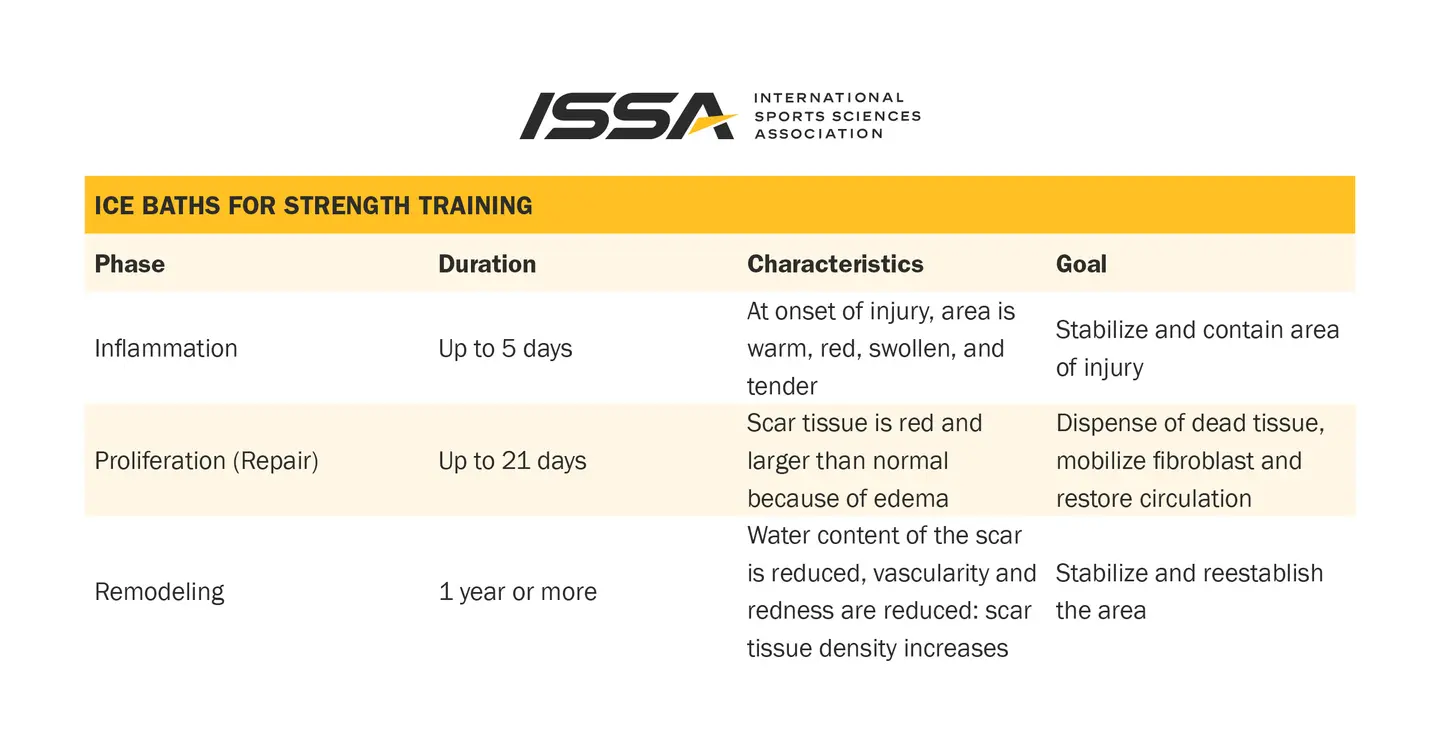
Ice Baths for Strength Training—Effective or Excessive?
Reading Time: 8 minutes 15 seconds
BY: ISSA
DATE: 2021-12-28
The use of cold therapies may seem like a fad, but recovery strategies like cryotherapy, cold water immersion (an ice bath), contrast therapy, a cold shower, and the use of ice are nothing new. Cold exposure has been found to help reduce physical fatigue and muscle soreness when timed appropriately around exercise.
Muscle soreness is largely genetic. This means that some people are more likely to have excessive or delayed muscle soreness from training while others may not be so afflicted. It is also based on activity type, intensity, and duration regardless of someone’s genetic predisposition for discomfort. It’s a good indicator that a training session was challenging enough to create micro-tears in muscle tissue. When the body begins to repair these small tears, it’s basically an immune response that causes inflammation, muscle tightness, and those wonderfully sore muscles.
If adequate recovery time is allowed, the muscles will repair and rebuild and come back better than before! The adaptations of increased muscle strength, force production, or size will occur assuming the proper stimulus was applied during training.
Want to learn more about training principles and training periodization? Check out these informative ISSA blog posts:
Understanding the Overload Principle
Whether you’re an athlete looking to get to the next level, a fitness pro working with high performers, or a science-minded solo warrior, understanding periodization and progression is vital for training success! Dive into the ISSA’s new and improved Strength and Conditioning certification today! Discover what it takes and how to apply it to get maximum athletic results!
The Problem: How Does the Body Recover from Training?
The process of muscle repair begins immediately after damage or training. There are three phases recognized as part of this process: inflammation, repair, and remodeling.
Inflammation: The body has an immune response to the micro-tearing of muscle tissue produced by training. Macrophages, lymphocytes, and satellite cells go to work to clean out damaged tissues and increase blood flow to the area. The result is localized swelling, redness, muscle stiffness, soreness, and, in some cases, a reduction in range of motion. Increased blood flow also ensures that oxygen and nutrients are being delivered to the damaged tissue.
This process can last for a few days and is a necessary process for full muscle recovery.
Repair: This phase often overlaps with the inflammation phase and new muscle tissue begins to form. This is called muscle protein synthesis (MPS). A structural collagen matrix is formed to support new tissue growth. This dense tissue can create scar tissue which can further limit muscle elasticity. Tight muscles will impair joint range of motion, so stiffness is common.
This phase can last for up to 21 days.
Remodeling: The body continues to repair and reinforce the damaged tissues. The swelling is greatly reduced and scar tissue, if still present, solidifies. Muscle growth and improved muscle strength can be quantified as muscle tissue returns to full functional capacity.
This phase can last for up to one year.
You read that right! Full recovery is an ongoing process and can last for up to one year after damage. For this reason, recovery techniques cannot be something that we do on occasion. Recovery strategies must be a part of a fitness routine just as much as a training schedule and a balanced diet for the best results!

When it comes to an ice bath or a cold therapy after training, the initial phase of inflammation is of the most importance. It is within the first 24-72 hours that most people feel the most fatigue and discomfort (muscle soreness). Let’s look at how an ice bath can reduce inflammation.
The Purpose: The Importance of Reducing Chronic Inflammation
Inflammation that results from strenuous training can be uncomfortable. Sore, tight, stiff muscles make it difficult to move around, continue to train, or even sit still! Water immersion in an ice bath has been found to have the following benefits for endurance athletes, strength and power athletes, and general exercisers alike:
Reduces local inflammation
Reduces perceived muscle soreness
Quickly cools the body’s core temperature
May temporarily boost metabolism*
*The immune and metabolic impacts are still being researched!
Let’s get this straight:
Inflammation - good
Chronic inflammation - bad
Chronic inflammation means that it never goes away. Lingering inflammation can eventually start to damage healthy cells, tissues, and organs and is linked to severe diseases and cancers.
An ice bath effectively forces the blood towards the core of the body. The blood vessels constrict in the exposed body region. This is a natural response in cold conditions—keep the brain and organs warm and functioning at the expense of the limbs and minimize heat loss. The reduced blood flow to the area, in turn, reduces inflammation as well.
After the immersion is complete and the body returns to baseline temperature, blood vessels dilate, and a fresh flow of oxygenated and nutrient-rich blood enters the area. It is thought that this process can also speed up the removal of metabolic waste products that build up in tissues (and contribute to muscle soreness and fatigue) after a training session.
While it is true that the cold temperatures work to reduce inflammation and can slow or deter MPS, it’s all about timing!
The Protocol: How to Execute an Ice Bath
First, let’s cover the safety tips. Talk to a physician before attempting cold water immersion if you have cold intolerances or blood pressure, heart, or circulation issues.
Now, let’s talk about when to execute an ice bath. You now understand that inflammation, while uncomfortable, is necessary for muscle repair. However, you don’t want it to last forever! Lots of research has been done (and more is needed) on applying cold water immersion (CWI) 30 minutes, 2 hours, 24 hours, and 48 hours after exercise.
It should be noted that there is research supporting the idea that seasonality matters as well. For example, an athlete who is in-season and competing in regular games or matches in their sport can benefit greatly from cold therapies since the therapies will relieve inflammation and help the athlete prepare faster for their next game or match. However, the research suggests that athletes who are off-season (or a gym-goer in a training cycle focused on building muscle size or strength) may not want to use cold therapies for the same reason. Some research has found that submerging body regions or limbs in cold water (8 degrees Celsius) immediately after resistance training can actually reduce MPS in that area. The inflammation process is cut short, which means the later phases of repair and remodeling cannot happen and muscle tissue does not have the opportunity to grow! This is most important for those trying to build muscle.
Interested in more of the science? Check out one of many research articles for more on how cold therapies may impact increases in cross-sectional muscle size (muscle growth)!
About 24 and 48-hours after activity, inflammation was allowed to occur and the CWI therapy helped reduce perceived muscle fatigue in most participants.
Now, the type of athlete matters with this therapy as well. Chronic endurance athletes like marathoners or long-distance track athletes train for longer durations with minimal rest or recovery time to force the adaptation of improved endurance. CWI has not been shown to be as beneficial for these types of athletes.
On the other hand, athletes and individuals who resistance train regularly should pay attention to the timing of CWI to avoid blunting the inflammation response. Based on a training schedule, 24-48 hours after exercise is an optimal time for CWI to allow for an inflammation response, the start of the repair process, and the promotion of training adaptations like strength and, more importantly, muscle growth (hypertrophy).
Temperature
The ideal temperature for an ice bath is between 50- and 59-degrees Fahrenheit (10-15 degrees Celsius).
Some people may have a lower tolerance to colder temperatures, so start conservative! Also, remember that moving water is colder than stagnant water. Much like the wind adds a wind chill factor in the snow, water that flows over the skin is, in fact, colder and that should be accounted for.
Time
These cold temperatures cannot be managed for long. Avoid skin damage or hypothermia by keeping a timer nearby. Most research found that 5 to 8 minutes elicited the appropriate vasoconstriction result desired for most people. Athletes and those accustomed to the therapy can remain submerged (in whole or partially) for 10 to 15 minutes.
Keep in mind that longer is not necessarily better! No benefits have been identified when CWI was executed for longer than 15 minutes at a time.
The Proxy: Alternate Ways to Cool Down After a Tough Strength Training Session
Sitting or standing in a pool of cold water may not be for everyone. There are plenty of other ways to get the same benefits of CWI!
Cryotherapy. Cryotherapy also exposes the whole body (or localized region) to cold temperatures. However, you don’t have to get wet while you do it! Cryotherapy is offered at a variety of locations including PT clinics, cryo clinics, and athletic training facilities.
Grab an ice pack. You can simulate the same response to other cold therapies with an ice pack. The same timing applies: 5 to 15 minutes max per body region. Use of an ice pack can be done immediately after exercise, but, if possible, allow 24-48 hours to apply.
Note that recovery applications of ice packs differ from applications in response to an injury. If there is an injury, an ice pack may be needed immediately to stop swelling.
A cold shower. For those just starting cold water therapies, a cool shower is a great alternative. When executed right after training, don’t go straight for the coldest water! Start with lukewarm water to begin cooling the body, reduce sweating, and cleanse the skin. The last 90 seconds to 2 minutes of your shower, slowly decrease the water temperature to as low as you can stand. Make sure the water flushes over major body regions like the back, legs, shoulders, and glutes.
An extended cool down. Short on time or no access to water after training? Extend your typical cool down after your session. A normal cool down should last between 5 and 10 minutes. Add an additional 10-15 minutes of stretching, a light walk on the treadmill, or a short walk outside, especially if it’s a nice or cooler day.
Add yoga to your routine. Research has found that stretching and massage are also great recovery techniques for reducing muscle soreness! Add yoga into your strength training routine a few times a week.
Clean your skin. If you’re short on time, grab a clean towel and dry your skin. Removing excess sweat can help you cool down and reduce the risk of clogged pores. If available, clean your skin with cleansing or anti-microbial wipes as well.
It should go without saying, but make sure these wipes were intended for use on the skin and not equipment wipes!
Change your clothes. When all else fails, cool down, dry off a bit, and change into a new set of clothes. All the way down to your underwear! Fresh, dry clothes can help the body cool itself, return to baseline heart rate and respiration quicker, and get the repair process underway!
Recovery is just as important as the actual exercise that makes it necessary! Help clients, or yourself, gain a competitive fitness advantage! Become more than a trainer. The ISSA’s Master Trainer Designation allows you to earn your certified personal trainer credential plus four additional fitness specializations of your choice! Your time is NOW!